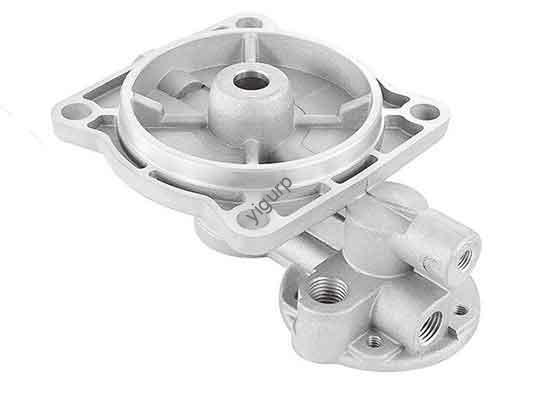If you’re developing prototypes or small-batch parts in Singapore, elenco de vácuo (also called urethane casting) é uma mudança de jogo. It uses a vacuum to draw liquid resin into silicone molds, creating high-precision parts that mimic production-grade materials—faster and cheaper than injection molding. For local businesses, it cuts R&D time by up to 50% and slashes tooling costs to 20-30% of traditional methods . Se você está em automóvel, eletrônica, ou dispositivos médicos, it bridges the gap between prototypes and market-ready products.
How Vacuum Casting Works: Um colapso passo a passo
The process is straightforward but requires precision—here’s how Singaporean manufacturers execute it:
- Criação de padrões mestre
Primeiro, a master model of your part is made using 3D impressão ou Usinagem CNC. Singaporean shops like RP World often use 3D printing for complex designs, ensuring the master matches your CAD file exactly . The master is inspected for flaws before moving forward.
- Fazendo moldes de silicone
The master is submerged in liquid silicone, which cures around it (tipicamente 24-48 horas). Once set, the mold is cut into two halves, and the master is removed—leaving a cavity that mirrors your part. These molds last 10-20 usos, dependendo da complexidade .
- Elenco de vácuo & Cura
Resina (Por exemplo, poliuretano) is poured into the mold, which is then placed in a vacuum chamber to eliminate air bubbles (critical for clear or detailed parts). The mold goes into an oven for 3-4 hours of constant-temperature curing . Finalmente, O molde está aberto, and the part gets post-processed (pintura, marcação a laser, etc.).
Exemplo de caso: A global automation firm in Singapore struggled with CNC-machined impeller assemblies that failed underwater tests. RP World switched to vacuum casting: they 3D-printed a master, made a silicone mold, and cast parts that passed long-term underwater trials—cutting production time by half and becoming the client’s long-term supplier .
Key Advantages of Vacuum Casting for Singapore Businesses
Why choose this over 3D printing or injection molding? Here’s how it benefits local teams:
- Velocidade: Get 20 peças em 15 days or less —ideal for tight R&D deadlines.
- Eficiência de custos: Silicone molds cost far less than steel/aluminum injection molds. Para 100 peças, vacuum casting saves 30-60% vs.. moldagem por injeção .
- Qualidade: Parts have superior surface finish (smoother than injection molding) and capture fine details like textures or undercuts .
- Flexibilidade: Usar 11+ resin types (Por exemplo, heat-resistant for automotive, transparent for lenses) and add post-processing like screen printing.
Top Materials for Vacuum Casting in Singapore
Singaporean suppliers offer a wide range of resins to match your part’s needs. Aqui está um guia rápido:
| Tipo de material | Propriedades -chave | Usos comuns |
| Hei-Cast PU 8150 | ABS-like rigidity | Gabinetes, casos |
| Axson PX 5212 | Transparente, alta clareza | Lentes, tampas de exibição |
| Hei-Cast 8752 | Flexível (semelhante a borracha) | Juntas, wearables |
| Resinas de alta temperatura | Resistência ao calor (até 200 ° C.) | Peças automotivas do motor |
Para a ponta: Jucheng Precision, a Singapore-certified (ISO 9001, Iatf 16949) shop, recommends Hei-Cast 8400 for parts needing both strength and impact resistance .
2025 Trends Shaping Vacuum Casting in Singapore
The industry is evolving fast—here’s what local businesses need to know:
- Automação & 24/7 Produção
Shops like SM Metal Solutions are adding automated mold prep and part extraction, reducing human error and enabling round-the-clock production . This boosts output by 30% while cutting labor costs.
- AI-Powered Optimization
AI systems now analyze casting cycles to predict mold maintenance and reduce waste. Por exemplo, AI can spot resin flow issues early, garantindo 99% of parts meet quality standards —critical for medical device makers.
- Eco-Friendly Resins
With Singapore’s strict sustainability rules, suppliers are adopting recyclable resins that cut waste to 5-10% (vs.. 20-30% para usinagem CNC) . Look for shops using bio-based polyurethanes.
How to Calculate Vacuum Casting Costs in Singapore
Costs depend on four factors—use this breakdown to budget:
- Material (40-60% of total cost): PU resins cost SGD 20-50 por kg; high-temp resins go up to SGD 80/kg .
- Mold Fees: A small mold (10x10cm) costs SGD 300-500; large/complex molds reach SGD 1,500 .
- Volume: Unit costs drop 40% when producing 100 vs.. 10 peças (spreads mold costs).
- Pós-processamento: Painting adds SGD 5-15 por parte; laser marking is SGD 2-8 por parte .
Exemplo: 50 ABS-like parts (10x5cm) com pintura: ~SGD 1,800 total (mofo: SGD 400, material: SGD 800, labor/post-processing: SGD 600).
Perspectiva da tecnologia YIGU
“Vacuum casting is the unsung hero of Singapore’s manufacturing ecosystem. We’ve seen clients cut R&D timelines by 60% using this method—especially in electronics, where fast prototyping wins markets. The key is partnering with shops that combine ISO certifications with AI tools: they deliver consistent quality while keeping costs low. As sustainability rules tighten, we’re advising clients to prioritize eco-resins—they don’t just meet regulations but also appeal to green-conscious buyers. Para pequenos lotes (10-500 peças), vacuum casting beats injection molding every time.”
Perguntas frequentes: Vacuum Casting Singapore
P: How long does vacuum casting take in Singapore?
UM: 7-10 dias para peças simples; Designs complexos (com pós-processamento) pegar 12-15 dias .
P: Can vacuum casting make metal parts?
UM: No—stick to plastics/rubbers. Para metais, Singaporean shops use die casting (Por exemplo, SM Metal Solutions) .
P: Is vacuum casting better than 3D printing?
UM: For functional prototypes or small batches, yes—parts have better material strength and surface finish . 3D printing is better for 1-5 peças.
P: Which industries use vacuum casting most in Singapore?
UM: Automotivo (impellers, caixas), eletrônica de consumo (Casos de telefone, wearables), e médico (device enclosures) .
